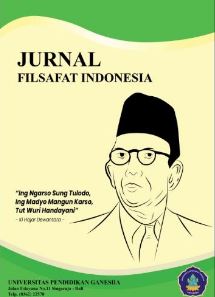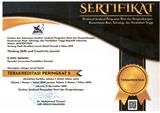Perkembangan Paradigma Metode Klasifikasi Citra Penginderaan Jauh dalam Perspektif Revolusi Sains Thomas Kuhn
DOI:
https://doi.org/10.23887/jfi.v6i3.53865Kata Kunci:
klasifikasi citra, penginderaan jauh, revolusi saintifik, Thomas KuhnAbstrak
Pesatnya peningkatan teknologi penginderaan jauh memunculkan tiga paradigma metode klasifikasi citra penginderaan jauh, yaitu berbasis piksel, berbasis objek, dan berbasis pemandangan. Artikel ini bertujuan untuk mengetahui perkembangan metode klasifikasi citra penginderaan jauh dan mengetahui proses revolusi saintifik Thomas Kuhn (pra-paradigma, sains normal, anomali, krisis, dan revolusi saintifik) yang terjadi pada perkembangan metode klasifikasi tersebut. Penyusunan artikel ini menggunakan metode kualitatif deskriptif. Data dikumpulkan dari berbagai sumber literatur ilmiah yang relevan, kemudian diuraikan tahapan revolusi sains terkait perkembangan metode klasifikasi citra penginderaan jauh. Paradigma I perkembangan metode klasifikasi citra penginderaan jauh dimulai pada tahun 1970-an, ketika pertama kali satelit Landsat diluncurkan. Pada paradigma ini digunakan klasifikasi citra penginderaan jauh berbasis piksel atau sub-piksel, karena resolusi spasial citra penginderaan jauh sangat rendah. Paradigma II (tahun 2000-an), digunakan metode klasifikasi berbasis objek karena lebih efisien daripada analisis berbasis piksel. Dirilisnya dataset penggunaan lahan (UC-Merced) pada tahun 2010-an, interpretasi citra penginderaan jauh berbasis pemandangan mulai digunakan, karena metode berbasis piksel dan objek tidak cukup mengklasifikasikan dengan benar.
Referensi
Baatz, M. (2000). Multiresolution segmentation: An optimization approach for high quality multiscale image segmentation. Angewandte geographische informationsverarbeitung, 12–23.
Berg, P., Pham, M.-T., & Courty, N. (2022). Self-Supervised Learning for Scene Classification in Remote Sensing: Current State of the Art and Perspectives. Remote Sensing, 14(16), 3995. https://doi.org/10.3390/rs14163995
Blaschke, T. (2010). Object Based Image Analysis for Remote Sensing. ISPRS journal of photogrammetry and remote sensing, 65(1), 2–16.
Blaschke, T., & Strobl, J. (2001). What’s Wrong With Pixels? Some Recent Developments Interfacing Remote Sensing and GIS. 12–17.
Campbell, J. B., & Wynne, R. H. (2011). Introduction to Remote Sensing. Guilford Press.
Cheng, G., Han, J., & Lu, X. (2017). Remote Sensing Image Scene Classification: Benchmark and State of the Art. Proceedings of the IEEE, 105(10), 1865–1883. https://doi.org/10.1109/JPROC.2017.2675998
Cheng, G., Xie, X., Han, J., Guo, L., & Xia, G.-S. (2020). Remote Sensing Image Scene Classification Meets Deep Learning: Challenges, Methods, Benchmarks, and Opportunities. IEEE Journal of Selected Topics in Applied Earth Observations and Remote Sensing, 13, 3735–3756. https://doi.org/10.1109/JSTARS.2020.3005403
Feyerabend, P. (2020). Against method: Outline of an Anarchistic Theory of Knowledge. Verso Books.
Fisher, P. F., & Pathirana, S. (1990). The Evaluation of Fuzzy Membership of Land Cover Classes In the Suburban Zone. Remote Sensing of Environment, 34(2), 121–132. https://doi.org/10.1016/0034-4257(90)90103-S
France, M. J., & Hedges, P. D. (1986). A Hydrological Comparison of Landsat TM, Landsat MSS And Black & White Aerial Photography. Remote Sensing for Ressources Development and Environmental Management. International symposium. 7, 717–720.
Haack, B. N. (1982). Landsat: A Tool for Development. World Development, 10(10), 899–909.
Herold, M., Gardner, M. E., & Roberts, D. A. (2003). Spectral Resolution Requirements for Mapping Urban Areas. IEEE Transactions on Geoscience and remote sensing, 41(9), 1907–1919.
Jensen, J. R. (2015). Introductory Digital Image Processing: A Remote Sensing Perspective (4th ed.). Pearson.
Kesuma, U., & Hidayat, A. W. (2020). Pemikiran Thomas S. Kuhn Teori Revolusi Paradigma. Islamadina : Jurnal Pemikiran Islam, 166. https://doi.org/10.30595/islamadina.v0i0.6043
Kirchhof, W., Haberäcker, P., Krauth, E., Kritikos, G., & Winter, R. (1980). Evaluation of LANDSAT Image Data for Land-Use Mapping. Acta Astronautica, 7(2), 243–253. https://doi.org/10.1016/0094-5765(80)90064-8
Kuhn, T. S. (1970). The Structure of Scientific Revolutions ([2d ed., enl). University of Chicago Press.
Lakatos, I. (1970). Falsification and the Methodology of Scientific Research Programmes. Dalam A. Musgrave & I. Lakatos (Ed.), Criticism and the Growth of Knowledge: Proceedings of the International Colloquium in the Philosophy of Science, London, 1965 (Vol. 4, hlm. 91–196). Cambridge University Press; Cambridge Core. https://doi.org/10.1017/CBO9781139171434.009
Li, M., Zang, S., Zhang, B., Li, S., & Wu, C. (2014). A Review of Remote Sensing Image Classification Techniques: The Role of Spatio-contextual Information. European Journal of Remote Sensing, 47(1), 389–411. https://doi.org/10.5721/EuJRS20144723
Lo, C. P. (1977). Landsat Images As A Tool In Regional Analysis: The example of Chu Chiang (Pearl River) delta in South China. Geoforum, 8(2), 79–87.
Lu, D., & Weng, Q. (2007). A Survey of Image Classification Methods And Techniques for Improving Classification Performance. International Journal of Remote Sensing, 28(5), 823–870. https://doi.org/10.1080/01431160600746456
Mahayana, D. (2022). Filsafat Sains: Dari Newton, Einstein hingga Sains-Data. ITB Press.
Mehmood, M., Shahzad, A., Zafar, B., Shabbir, A., & Ali, N. (2022). Remote Sensing Image Classification: A Comprehensive Review and Applications. Mathematical Problems in Engineering, 2022, 1–24. https://doi.org/10.1155/2022/5880959
Newman, M. E., McLaren, K. P., & Wilson, B. S. (2011). Comparing the Effects of Classification Techniques on Landscape-Level Assessments: Pixel-Based Versus Object-Based Classification. International Journal of Remote Sensing, 32(14), 4055–4073.
Phan, M. H., & Stive, M. J. F. (2022). Managing Mangroves and Coastal Land Cover in the Mekong Delta. Ocean & Coastal Management, 219, 106013. https://doi.org/10.1016/j.ocecoaman.2021.106013
Shivakanth, G., & Tanwar, P. S. (2018). Review On Conventional and Advanced Classification Approaches in Remote Sensing Image Processing. International Journal of Computer Sciences and Engineering, 6(11), 871–879. https://doi.org/10.26438/ijcse/v6i11.871879
Shlien, S., & Smith, A. (1975). A Rapid Method to Generate Spectral Theme Classification of LANDSAT Imagery. Remote Sensing of Environment, 4, 67–77. https://doi.org/10.1016/0034-4257(75)90006-1
Spurr, S. H. (1952). Aerial Photographs in Forest Management. Photogrammetria, 9, 33–41. https://doi.org/10.1016/S0031-8663(52)80004-3
Thompson, M. M., & Mikhail, E. M. (1976). Automation in Photogrammetry: Recent Developments and Applications (1972–1976). Photogrammetria, 32(4), 111–145. https://doi.org/10.1016/0031-8663(76)90008-9
Zhang, T., Yang, X., Hu, S., & Su, F. (2013). Extraction of Coastline in Aquaculture Coast from Multispectral Remote Sensing Images: Object-Based Region Growing Integrating Edge Detection. Remote sensing, 5(9), 4470–4487.
Zhao, Q., Yu, L., Du, Z., Peng, D., Hao, P., Zhang, Y., & Gong, P. (2022). An Overview of the Applications of Earth Observation Satellite Data: Impacts and Future Trends. Remote Sensing, 14(8), 1863. https://doi.org/10.3390/rs14081863
Zhou, W., Troy, A., & Grove, M. (2008). Object-Based Land Cover Classification and Change Analysis In The Baltimore Metropolitan Area Using Multitemporal High Resolution Remote Sensing Data. Sensors, 8(3), 1613–1636.
Unduhan
Diterbitkan
Terbitan
Bagian
Lisensi
Hak Cipta (c) 2023 Jurnal Filsafat Indonesia

Artikel ini berlisensiCreative Commons Attribution-ShareAlike 4.0 International License.

Jurnal Filsafat Indonesia Undiksha is licensed under a Creative Commons Attribution-ShareAlike 4.0 International License.




